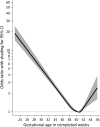Gestational age at birth and risk of intellectual disability without a common genetic cause
- PMID: 29214412
- PMCID: PMC6061122
- DOI: 10.1007/s10654-017-0340-1
Gestational age at birth and risk of intellectual disability without a common genetic cause
Abstract
Preterm birth is linked to intellectual disability and there is evidence to suggest post-term birth may also incur risk. However, these associations have not yet been investigated in the absence of common genetic causes of intellectual disability, where risk associated with late delivery may be preventable. We therefore aimed to examine risk of intellectual disability without a common genetic cause across the entire range of gestation, using a matched-sibling design to account for unmeasured confounding by shared familial factors. We conducted a population-based retrospective study using data from the Stockholm Youth Cohort (n = 499,621) and examined associations in a nested cohort of matched outcome-discordant siblings (n = 8034). Risk of intellectual disability was greatest among those born extremely early (adjusted OR24 weeks = 14.54 [95% CI 11.46-18.44]), lessening with advancing gestational age toward term (aOR32 weeks = 3.59 [3.22-4.01]; aOR37weeks = 1.50 [1.38-1.63]); aOR38 weeks = 1.26 [1.16-1.37]; aOR39 weeks = 1.10 [1.04-1.17]) and increasing with advancing gestational age post-term (aOR42 weeks = 1.16 [1.08-1.25]; aOR43 weeks = 1.41 [1.21-1.64]; aOR44 weeks = 1.71 [1.34-2.18]; aOR45 weeks = 2.07 [1.47-2.92]). Associations persisted in a cohort of matched siblings suggesting they were robust against confounding by shared familial traits. Risk of intellectual disability was greatest among children showing evidence of fetal growth restriction, especially when birth occurred before or after term. Birth at non-optimal gestational duration may be linked causally with greater risk of intellectual disability. The mechanisms underlying these associations need to be elucidated as they are relevant to clinical practice concerning elective delivery around term and mitigation of risk in post-term children.
Keywords: Gestational age; Intellectual disability; Post-term birth; Regression splines; Siblings; Stockholm Youth Cohort.
Conflict of interest statement
Conflict of interest statement
The authors declare having no conflicting interests.
Ethical approval
Ethical approval for this study was granted by the research ethics committee at Karolinska Institute [2010/1185-31/5 and 2013/1118-32], allowing record linkage without personal consent when the confidentiality of the individuals is maintained. The personal identity of participants was replaced with a serial number before the research group were given access to these data.
Figures



References
-
- American Psychiatric Association. Diagnostic and statistical manual of mental disorders: DSM-IV. Washington DC: American Psychiatric Association (APA); 1994.
-
- World Health Organisation. Definition: intellectual disability. WHO. 2016. http://www.euro.who.int/en/health-topics/noncommunicable-diseases/mental.... Accessed 05 May 2016.
-
- King BH, Toth KE, Hodapp RM, Dykens EM. Intellectual disability. In: Sadock BJSV, Ruiz P, editors. Comprehensive textbook of psychiatry. 9. Philadelphia: Lippincott Williams & Wilkins; 2009. pp. 3444–3474.
MeSH terms
Grants and funding
LinkOut - more resources
Full Text Sources
Other Literature Sources
Medical

